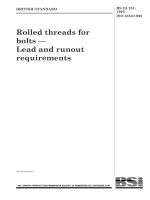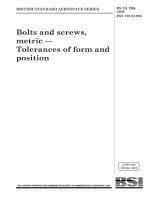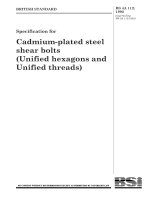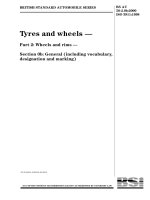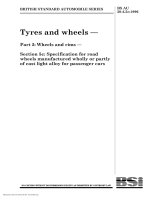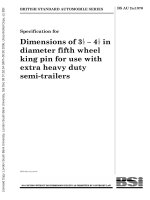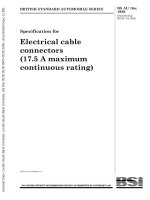Bsi bs au 193a 1990 (1999)
Bạn đang xem bản rút gọn của tài liệu. Xem và tải ngay bản đầy đủ của tài liệu tại đây (391.41 KB, 14 trang )
BRITISH STANDARD AUTOMOBILE SERIES
BS AU 193a:
1990
(Superseding
BS AU 193:1 983)
Specification for
Replacement motor
cycle and moped
exhaust systems
BS AU 193a:1990
Committees responsible for this
British Standard
The preparation of this British Standard was entrusted by the Automobile
Standards Policy Committee (AUE/- ) to Technical Committee AUE/9, upon
which the following bodies were represented:
Automobile Association
Consumer Policy Committee of BSI
Department of Trade and Industry (Consumer Safety Unit, C A Division)
Department of Transport
Garage Equipment Association
Institute of Trading Standards Administration
Motor Agents Association Ltd.
Motor Cycle Industry’s Association of Great Britain Ltd.
Royal Automobile Club
Society of Motor Manufacturers and Traders Ltd.
This British Standard, having
been prepared under the
direction of the Automobile
Standards Policy Committee
was published under the
authority of the Board of BSI
and comes into effect on
29 June 1 990
© BSI 09- 1 999
First published September 1 983
Second edition June 1 990
The following BSI references
relate to the work on this
standard:
Committee reference AUE/9
Draft for comment 89/76935 DC
ISBN 0580 18492 7
Amendments issued since publication
Amd. No.
Date of issue
Comments
BS AU 193a:1990
Contents
Page
Committees responsible
Inside front cover
Foreword
ii
1
Scope
1
2
Definitions
1
3
General
1
4
Fibrous material
1
5
Permissible noise level
1
6
Marking and packaging
2
Appendix A Tests for durability of fibrous material
3
Appendix B Conditioning of exhaust systems containing
fibrous material
3
Appendix C Methods of measuring noise levels
4
Figure 1 — Test apparatus for conditioning by pulsation
7
Figure 2 — Arrangement of test for measuring motor cycle
noise (vehicle in motion)
8
Table 1 — Maximum noise level for motor cycles or mopeds of type A
2
Table 2 — Maximum noise level for motor cycles or mopeds of type B
2
Table 3 — Maximum noise level for motor cycles or mopeds of type C
2
Table 4 — Distances to be completed during conditioning
3
Table 5 — Number of test bench cycles to be completed by each class
of motor cycle or moped
4
Table 6 — One test bench cycle
4
Publications referred to
© BSI 09- 1 999
Inside back cover
i
BS AU 1 93 a: 1 990
Foreword
This British Standard has been prepared under the direction of the Automobile
Standards Policy Committee with the assistance of the Department of Transport.
It supersedes BS AU 1 93: 1 983, which is withdrawn. This revision reflects the
Department of Transport’s adoption of the directive 78/1 01 5/EEC, amended by
the directives 87/56/EEC and 89/235/EEC, on noise limits and replacement
silencers.
This British Standard differs from the previous edition in that the following items
have been included:
a) definitions of motor cycle of type C (see
2.3)
and moped of type C (see
b) maximum noise levels for type C machines (see
2 . 6) ;
5 . 3 );
c) a method to condition exhaust systems by pulsation (see
B. 3 ) .
A British Standard does not purport to include all the necessary provisions of a
contract. Users of British Standards are responsible for their correct application.
C omp liance with a British S tand ard d oes no t of itself confe r immunity
from legal ob ligatio ns.
S ummary of p age s
This document comprises a front cover, an inside front cover, pages i and ii,
pages 1 to 8, an inside back cover and a back cover.
This standard has been updated (see copyright date) and may have had
amendments incorporated. This will be indicated in the amendment table on the
inside front cover.
ii
© BSI 09- 1 999
BS AU 1 93 a: 1 990
1 S cop e
This British Standard specifies requirements for the
silencing properties of replacement exhaust systems
or parts thereof for installation on motor cycles and
mopeds. It describes methods for measuring the
noise emitted by motor cycles and mopeds fitted
with these systems and specifies requirements for
the durability of fibrous noise absorbing materials
2.6
mo p e d o f typ e C
a two- wheeled or three- wheeled vehicle first used on
or after 1 April 1 991 that has a maximum design
speed not exceeding 50 km/h, a kerb- side mass not
exceeding 250 kg and, if propelled by an internal
combustion engine, an engine capacity not
exceeding 50 cm 3
where these are used to meet the noise limits. It also
2.7
includes requirements for marking these exhaust
exhaust syste m
systems and their packaging and for the supply of
a complete set of components through which the
installation literature.
exhaust gases escape from the engine unit,
NOTE
The titles of the publications referred to in this standard
are listed on the inside back cover.
2 D e finitions
including those that are necessary to limit the noise
caused by the escape of these gases
2.8
fib ro us materials
For the purposes of this British Standard the
following definitions apply.
2.1
mo tor cycle of typ e A
a mechanically propelled vehicle, not being an
invalid carriage, with less than four wheels and an
unladen mass that does not exceed 400 kg, first
used between 1 April 1 970 and 31 March 1 983
2.2
motor cycle of typ e B
a two- wheeled vehicle, with or without sidecar,
fitted with an engine intended for use on the
road and having a maximum design speed
of more than 50 km/h, first used
between 1 April 1 983 and 31 March 1 991
2.3
motor cycle of typ e C
a two- wheeled vehicle, with or without sidecar,
fitted with an engine intended for use on the road
and having a maximum design speed of more
than 50 km/h, first used on or after 1 April 1 991
materials of a fibrous nature that are placed within
the exhaust system to limit the noise caused by the
escape of the exhaust gases
2.9
maximum rate d p ow e r sp e e d
S)
(
the engine speed at which the motor cycle or moped
develops maximum power
3 General
Exhaust systems shall be tamper- resistant so far as
may be compatible with clearly defined
maintenance and installation requirements.
4 Fib rous mate rial
4.1
Fibrous material shall not be used in the
manufacture of exhaust systems unless it is
asbestos- free and complies with
4.2
or
4.3 .
In
addition, means shall be provided to keep the
fibrous material in place.
4.2
The exhaust gases shall not be directed through
the fibrous material. The fibrous material shall
2.4
have a durability commensurate with the exhaust
mop e d o f typ e A
system and shall comply with Appendix A.
a two- wheeled or three- wheeled vehicle first used
between 1 April 1 970 and 31 March 1 983 that has
a maximum design speed not exceeding 50 km/h, a
kerb- side mass not exceeding 250 kg and, if
propelled by an internal combustion engine, an
engine capacity not exceeding 50 cm 3
2.5
mop ed of typ e B
a two- wheeled or three- wheeled vehicle first used
4.3
Exhaust systems containing fibrous absorbent
material shall be prepared for testing in accordance
with Appendix B, or by removing the fibrous
material from the exhaust system.
5 Pe rmissib le noise leve l
5.1
The maximum noise level for motor cycles or
mopeds of type A, when tested in accordance
with
C.4.2.2 ,
shall be as given in Table 1 .
between 1 April 1 983 and 31 March 1 991 that has
a maximum design speed not exceeding 50 km/h, a
kerb- side mass not exceeding 250 kg and, if
propelled by an internal combustion engine, an
engine capacity not exceeding 50 cm 3
© BSI 09- 1 999
1
BS AU 1 93 a: 1 990
Tab le 1 — Maximum no ise leve l for mo tor
6 Marking and p ackaging
cycles o r mop e ds o f typ e A
6. 1
E ngine cap acity
cm
Maximu m no ise
3
Mopeds
77
Motor cycles not exceeding 50
77
le ve l
information in a position such that it is readily
dB(A)
visible when fitted to the motor cycle or moped:
a) the number and date of this British Standard
and an indication of which of the three
tests in Appendix C was used,
Motor cycles greater than 50
but not more than 1 25
82
Motor cycles greater than 1 25
86
5.2
Each silencer of an exhaust system shall be
clearly and indelibly marked with the following
i. e. BS AU 1 93a: 1 990
1)
/T1 , /T2 or /T3;
b) the registered name or trade mark of the
exhaust system manufacturer.
The maximum noise level for motor cycles or
The manufacturer’s part number shall also be
mopeds of type B, when tested in accordance
clearly and indelibly marked on each component of
with
the exhaust system (excluding fixings).
C.4.2.3,
shall be as given in Table 2.
Tab le 2 — Maximum no ise leve l for mo tor
E ngine cap acity
Maximu m no ise
cm 3
Mopeds
a) the number and date of this British Standard
and an indication of which of the three
tests in Appendix C was used,
i. e. BS AU 1 93a: 1 990
78
/T1 , /T2 or /T3;
of the exhaust system manufacturer or, in the
80
case of imported goods, those of the UK supplier;
c) a list of the specific motor cycle or moped
83
models for which the system is suitable.
Motor cycles greater than 350
but not more than 500
85
Motor cycles greater than 500
86
5.3
1)
b) the registered name or trade mark and address
Motor cycles greater than 1 25
but not more than 350
indelibly marked with the following information:
dB(A)
Motor cycles greater than 80
but not more than 1 25
The exhaust system shall be supplied with
le ve l
73
Motor cycles not exceeding 80
6. 2
packaging, or labelling, which shall be clearly and
cycle s o r mop e ds o f typ e B
In addition, the manufacturer of the exhaust system
shall supply instructions that detail the correct
method of attachment to the motor cycle or moped,
The maximum noise level for motor cycles or
instructions for maintenance of the exhaust system
mopeds of type C, when tested in accordance
and a list of component parts with the
with
corresponding part numbers (excluding fixings).
C.4.2.4,
shall be as given in Table 3.
Tab le 3 — Maximum no ise leve l for mo tor
cycle s o r mop e ds o f typ e C
E ngine cap acity
Maximu m no ise
le ve l
cm
3
dB(A)
Mopeds
73
Motor cycles not exceeding 80
77
Motor cycles greater than 80
but not more than 1 75
79
Motor cycles greater than 1 75
82
1)
Marking BS AU 1 93a: 1 990 on or in relation to a product represents a manufacturer’s declaration of conformity, i. e. a claim by
or on behalf of the manufacturer that the product meets the requirements of the standard. The accuracy of the claim is therefore
solely the responsibility of the person making the claim. Such a declaration is not to be confused with third party certification of
conformity, which may also be desirable.
2
© BSI 09- 1 999
BS AU 1 93 a: 1 990
Ap p e ndix A Te sts for durab ility of
fib rous material
The material shall withstand a temperature
of 650 ± 5 °C for 4 h in a muffle furnace without
reduction of average fibre length, diameter of fibre
or bulk density.
After heating at 650 ± 5 °C for 1 h in a muffle
furnace, at least 98 % of the material shall
be retained in a sieve of nominal aperture
size 250 4m (60 mesh) complying with BS 410
when tested in accordance with BS 1796.
The loss in mass of material shall not
exceed 10.5 % after soaking for 24 h at 90 ± 5 °C in
synthetic exhaust condensate of the following
composition:
hydrobromic acid c (HBr) = 1 mol/L
10 mL
10 mL
sulphuric acid c (H2SO 4) = 5 mol/L
distilled water to make up to
1 000 mL.
A. 1
A. 2
A. 3
NOTE The material should be washed in distilled water and
dried for 1 h at 105 °C before weighing.
Ap p e ndix B C onditioning of e xhaust
systems containing fib rous mate rial
B. 1 Ge ne ral
Before testing in accordance with Appendix C,
exhaust systems containing fibrous material shall
either be conditioned in accordance with ,
or or the fibrous material shall be removed.
B. 2
B. 3
B. 4
B. 2 . 3
B. 3 C onditioning b y p ulsatio n
The exhaust system shall be fitted to the
motor cycle or to the engine. In the former case, the
motor cycle shall be mounted on a roller
dynamometer. In the latter case, the engine shall be
mounted on a test bench.
The test apparatus shall be fitted at the outlet of the
exhaust system.
B. 3 . 1
NOTE A typical test apparatus is shown in Figure 1 but other
apparatus that provides equivalent results may be used.
The test equipment shall be adjusted so that
the flow of exhaust gases is alternately interrupted
and restored 2 500 times by a rapid-action valve.
The valve shall open when the exhaust gas
back-pressure, measured at least 100 mm
downstream of the2) intake flange, reaches a value of
between 0.35 bar and 0.40 bar. If such a figure is
unattainable because of the engine characteristics,
the valve shall then open when the gas
back-pressure reaches a level equivalent to 90 % of
the maximum that can be measured before the
engine stops. It shall close when this pressure does
not differ by more than 10 % from its stabilized
value with the valve open.
The time-delay switch shall be set for the
duration of the exhaust gases calculated on the
basis of the requirements in
.
Engine speed shall be 75 % of the maximum
rated power speed (S).
The power indicated by the dynamometer
shall be 50 % of the full-throttle power measured
at 75 % of S.
Any drainage holes shall be closed off during
the test.
The entire test shall be completed within 48 h.
If necessary, a cooling period shall be allowed after
each hour.
B. 3 . 2
B. 3 . 3
B. 3 . 4
B. 3 . 3
B. 2 C o ntinuous road o p e ration
The minimum distances to be completed by
mopeds and motor cycles during conditioning shall
be as given in Table 4. Town driving shall account
for 50 ± 10 % of the operation and long-distance
runs shall account for the remainder.
B. 2 . 1
NOTE Continuous road operation may be replaced by a
corresponding track programme.
Tab le 4 — D istance s to b e comp le te d during
co nditioning
E ngine cap acity
D istance
cm3
km
Mopeds
2 000
Motor cycles not exceeding 80
4 000
Motor cycles greater than 80
6 000
but not more than 175
8 000
Motor cycles greater than 175
Town driving and long distance runs shall be
alternated on at least six occasions.
B. 2 . 2
The complete test programme shall include a
minimum of 10 breaks, each of at least 3 h, in order
to reproduce the effects of cooling and any
condensation.
B. 3 . 5
B. 3 . 6
B. 3 . 7
B. 3 . 8
B. 4 C o nd itioning o n a test b ench
The exhaust system shall be fitted to an
engine representative of the type fitted in the motor
cycle or moped for which the system is designed,
coupled to a dynamometer.
Conditioning shall consist of the specified
number of test bench cycles for the class of motor
cycle or moped for which the exhaust system is
intended. The number of cycles for each class of
vehicle shall be as given in Table 5.
B. 4 . 1
B. 4 . 2
2) 1 bar = 100 kN/m 2 = 100 KPa.
© BSI 09-1999
3
BS AU 1 93 a: 1 990
Tab le 5 — Numb er of test b e nch cycles to b e
comp lete d b y each class of mo tor cycle o r
E ngine cap acity
Nu mb e r o f
cycle s
3
Mopeds
3
Motor cycles not exceeding 80
6
Motor cycles greater than 80
9
but not more than 175
12
Motor cycles greater than 175
Each test bench cycle shall be followed by a break of
at least 6 h in order to reproduce the effects of
cooling and any condensation.
Each test bench cycle shall consist of six
phases. The engine conditions for, and the duration
of, each phase shall be as given in Table 6.
B. 4 . 3
Tab le 6 — O ne te st b ench cycle
Phase
C o nd itio ns
Minimu m d u ratio n
o f p hase
E ngine s
E ngine s
no t ab o ve
ab o ve
1 7 5 cm
a
b
c
d
e
f
idling speed
25 % load at 75 % of S
50 % load at 75 % of S
100 % load at 75 % of S
50 % load at 100 % of S
25 % load at 100 % of S
Total
min
6
40
40
30
12
22
2.5 h
3
1 7 5 cm
3
min
6
50
50
10
12
22
2.5 h
NOTE During conditioning, at the request of the
manufacturer, the engine and silencer may be cooled in order
that the temperature recorded, at a point no more than 100 mm
from the exhaust port outlet, when the motor cycle or moped is
running at 110 km/h or 75 % of S in top gear, whichever is the
lesser, is not exceeded. The engine and/or motor cycle or moped
speed and load are determined to within ± 3 %.
Ap p e ndix C Me thods of me asuring
noise le ve ls
C . 1 Pre p aration of motor cycle or mop e d for
test
Where an exhaust system is intended for use
on several variants of a motor cycle or moped based
on the same engine type and capacity but with
differing power outputs, a worst case vehicle shall
be selected.
C.1 .3
mop ed
cm
NOTE Where a motor cycle is fitted with a sidecar, this should
where possible, be removed for the purpose of the test.
NOTE The worst case vehicle is generally taken as the variant
with the highest engine power for that model, but other factors
that could affect the overall noise level, such as overall gearing
and intake systems, should be taken into account in the selection.
C . 2 Te st site
The test site shall consist of a central
acceleration area surrounded by a substantially flat
area. The acceleration area shall be flat and its
surface shall be such that rolling noise is
consistently low.
The test site shall be such that hemispherical
divergence exists to within ± 1 dB(A) between
a sound source at the centre of the test area
and microphone, i.e. the sound radiation is
within ± 1 dB(A) of the theoretical value for a point
source on a plane reflecting surface.
C.2.1
NOTE This condition is satisfied if there are no large objects
that reflect sound, such as fences, rocks, bridges or buildings,
within 50 m of the centre of the test area.
The surface of the site shall be made of hard
material, such as concrete or asphalt, within a
minimum radius of 10 m around the centre of the
test site and shall be free of powdery snow, tall
grass, loose soil and cinders.
The microphone shall not be obstructed in any way
that could affect the sound field, and no person shall
stand between the microphone and the sound
source.
The observer carrying out the measurements shall
so position himself as not to affect the readings of
the measuring instrument.
Measurements shall not be taken in
unfavourable meterological conditions nor in
gusting winds.
For measurements, the A-weighted sound
level (see BS 5969) of sound sources other than
those of the motor cycle or moped to be tested or of
wind effects shall be at least 10 dB(A) below the
sound level produced by the vehicle.
C.2.2
C.2.3
NOTE A suitable windscreen may be fitted to the microphone
The motor cycle or moped shall comply with provided
account is taken of its effect on the sensitivity and
the manufacturer’s specification for the model for directionalthatcharacteristic
of the microphone.
which the exhaust system is intended with the
exception of any alterations necessary to
Precision sound level meter, complying at least
accommodate the item(s) under test.
with
the
for type 1 of BS 5969, or
If the motor cycle or moped is fitted with fans complyingrequirements
with
the
specification
of the meter for the
with an automatic actuating mechanism, this
original
motor
cycle’s
approval
procedure.
system shall not be interfered with. For vehicles
having more than one driven wheel, only the drive
for normal road operation shall be used.
C.1 .1
C . 3 Ap p aratus
C.3.1
C.1 .2
4
© BSI 09-1999
BS AU 1 93 a: 1 990
C . 4 Proced ure
C.4.1
Method of measurement
Before any measurements are made, bring the
motor cycle or moped engine to the normal operating
temperature.
Carry out acoustic measurements using the fast
response time and the A-weighting curve. At the
beginning and end of each series of measurements,
calibrate the sound level meter in accordance with
the manufacturer’s instructions using a suitable
sound source, e.g. a pistonphone.
Using the precision sound level meter (
),
measure the maximum sound level in A-weighted
decibels [dB(A)] as the motor cycle or moped is
driven between lines AA and BB (see Figure 2).
Ignore any peak value that is obviously out of
character with the general sound level shown on the
instrument.
Locate the microphone on reference line
PP, 7.5 ± 0.2 m from reference line CC
(see Figure 2) of the track and 1.2 ± 0.1 m above
the ground. Ensure that the axis of maximum
sensitivity is horizontal and perpendicular to the
path of the vehicle (line CC).
Ensure that the test motor cycle or moped
approaches line AA at an initial steady speed as
described in
. When the front end of the vehicle
reaches line AA, open the throttle as quickly as
possible to the fully open position. Maintain this
position until the rear end of the vehicle reaches line
BB. Return the throttle as quickly as possible to the
idle position.
C.3.1
C.4.2
C.4.2
Approach condition
C.4.2.1
C .4.2.3.1
C.4.2.3.1
C.4.2.4.1
C.4.2.4.1
C.4.2.4.1
© BSI 09-1999
.
Ensure that the motor cycle or moped
approaches line AA at a steady speed that is the
lowest of the following:
a) a speed corresponding to 75 % of the maximum
rated power speed (S);
b) a speed corresponding to 75 % of the engine
speed permitted by the governor;
c) a road speed of 50 km/h.
Determine the engine and/or motor cycle or moped
speed to within ± 3 %.
If the motor cycle or moped is fitted with a
non-automatic gearbox with no more than four
speeds, use second gear. If it is fitted with a
non-automatic gearbox with more than four speeds,
use third gear.
Do not engage auxiliary step-up gears (“overdrive”).
If the vehicle is fitted with an auxiliary reduction
gearbox, use the latter with a gear ratio that allows
the highest vehicle speed.
If the motor cycle or moped is fitted with
an automatic gearbox with a selector having
alternative forward drive positions, test in the
position that results in the highest sound level on
the vehicle between lines AA and BB.
Exclude the selector position that is used only for
engine braking or for parking or similar slow
manoeuvres of the motor cycle or moped.
If the transmission is provided with full manual
override, carry out an additional test in accordance
with
.
If the motor cycle or moped is fitted with a manually
operated auxiliary reduction gearbox, use this in the
ratio allowing the highest vehicle speed.
C.4.2.2.1
C.4.2.2.2
C.4.2.2.3
C.4.2.2.2
General. In the case of an exhaust system
designed for use on a motor cycle or moped of type A,
ensure that the test machine approaches line AA in
accordance with
,
or
, as
requested by the exhaust system manufacturer. In
the case of an exhaust system designed for use on a
motor cycle or moped of type B, ensure that the test
machine approaches line AA in accordance
with
or
. In the case of an
exhaust system designed for use on a motor cycle or
moped of type C, ensure that the test machine
approaches line AA in accordance with
.
For all measurements, drive the motor cycle or
moped in a straight line over the acceleration
section in such a way that the longitudinal median
plane of the machine is as close as possible to line
CC.
Measure systems with adjustable elements that
could affect their efficiency in the conditions of
maximum noise level.
C .4.2.2.1
Test 1: measurement of the permissible noise
level from a motor cycle or moped of type A
C.4.2.2
C . 4 . 2 . 3 Test 2: measurement of the permissible noise
level from a motor cycle or moped of type B
.
NOTE At the request of the exhaust system manufacturer this
method may be used for motor cycles or mopeds first used prior
to 1 April 1983.
Ensure that the motor cycle or moped
approaches line AA at a steady speed that is one of
the following:
a) less than 50 km/h, the speed of rotation of the
engine being equal to 75 % of S;
b) 50 km/h, the speed of rotation of the engine
being between 50 % and 75 % of S;
c) more than 50 km/h, the speed of rotation of the
engine being equal to 50 % of S.
Determine the engine and/or motor cycle or moped
speed to within ± 3 %.
C.4.2.3.1
5
BS AU 1 93 a: 1 990
If the motor cycle or moped is fitted with a
non-automatic gearbox with not more than four
ratios, engage second gear.
If the motor cycle or moped is fitted with a
non-automatic gearbox with more than four ratios:
a) engage the third gear for vehicles with a cubic
capacity of not more than 350 cm3.
b) engage the second gear for vehicles with a cubic
capacity of more than 350 cm3.
If the motor cycle or moped is fitted with an
automatic gearbox with a selector, ensure that the
selector is in the position immediately below the
position corresponding to the maximum speed of the
vehicle.
C.4.2.3.2
Test 3: measurement of the permissible noise
level from a motor cycle or moped of type C.
C.4.2.4
NOTE At the request of the exhaust system manufacturer this
method may be used for motor cycles or mopeds first used prior
to 1 April 1991.
Ensure that the motor cycle or moped
approaches line AA at a steady speed that is one of
the following:
a) for machines fitted with a non-automatic
gearbox, the lowest of:
1) 50 km/h;
2) an engine speed corresponding to 75 % of S;
b) for machines fitted with an automatic gearbox
without manual override, whichever produces the
highest sound level:
1) 50 km/h;
2) 40 km/h;
3) 30 km/h;
4) 75 % of its maximum road speed if this value
is lower;
c) for machines fitted with an automatic gearbox
with a manual override:
1) less than 50 km/h, the speed of rotation of
the engine being equal to 75 % of S; or
2) 50 km/h, the speed of rotation of the engine
being less than 75 % of S; if a change-down
to first gear occurs, approach at a speed of
up to 60 km/h sufficient to avoid such a
change-down.
Determine the engine and/or motorcycle or moped
speed to within ± 3 %.
If the motor cycle or moped is fitted with a
non-automatic gearbox with not more than four
ratios, engage second gear.
If the motor cycle or moped is fitted with a
non-automatic gearbox with more than four ratios:
a) for vehicles with a cubic capacity of not more
than 175 cm3, engage third gear;
C.4.2.4.1
C.4.2.4.2
6
b) for vehicles with a cubic capacity of more
than 175 cm3, engage second gear and then
repeat the test engaging third gear.
If, during any test conducted in second gear, the
engine speed is more than 110 % of S as the machine
approaches line BB, the test is to be conducted in
third gear.
If the motor cycle or moped is fitted with an
automatic gearbox with manual override, ensure
that the selector is in the highest position consistent
with the avoidance of an automatic change-down
(kick-down).
C . 5 Recording o f results
For a motor cycle or moped tested in
accordance with
, measurements shall be
made on at least three runs in each direction. The
readings on a given side of the vehicle shall be
within 3 dB(A). If the range of readings on any one
side exceeds 3 dB(A), the whole test shall be
repeated.
The arithmetic mean of each set of three readings on
either side of the motor cycle or moped shall be
calculated. The highest average, to the nearest
decibel shall be taken to be the sound level of the
vehicle.
For a motor cycle or moped tested in
accordance with
at least two measurements
shall be taken either side of the vehicle.
Readings shall be rounded to the nearest decibel.
Only measurements having variations in two
consecutive tests on the same side of the machine of
less than or equal to 2 dB(A) shall be valid.
To take into account inaccuracies in the
measurements, the results of each measurement
shall be arrived at by deducting 1 dB(A) from the
meter reading.
The highest of the four results recorded shall be
taken to be the sound level of the vehicle.
For a motor cycle or moped tested in
accordance with
at least two measurements
shall be taken either side of the vehicle. If the
provisions of
b) apply, each measurement
shall be taken to be the mean of two consecutive
readings taken with the second gear and then the
third gear engaged.
Readings shall be rounded to the nearest decibel.
Only measurements having variations in two
consecutive tests on the same side of the machine of
less than or equal to 2 dB(A) shall be valid.
To take into account inaccuracies in the
measurements, the results of each measurement
shall be arrived at by deducting 1 dB(A) from the
meter reading.
The highest of the four results recorded shall be
taken to be the sound level of the vehicle.
C.5.1
C.4.2.2
C.5.2
C.4.2.3
C.5.3
C.4.2.4
C .4.2.4.2
© BSI 09-1999
BS AU 193a:1990
Figure 1 — Test apparatus for conditioning by pulsation
©
BSI 09- 1 999
7
BS AU 1 93a:1 990
Figure 2 — Arrangement of test for measuring motor cycle noise level (vehicle in motion)
8
©
BSI 09- 1 999
BS AU 193a:1990
Publications referred to
BS 41 0 , Sp ecification for test siev es.
BS 1 7 96, Method of test siev ing.
BS 5 9 69 , Sp ecificatio n for so und lev el m etres.
©
BS I 0 9- 1 99 9
BS AU 193a:
1990
BSI — British Standards Institution
BS I is the indep endent national b ody res p ons ib le for p rep aring
Britis h S tandards . It p res ents the UK view on s tandards in E urop e and at the
international level. I t is incorp orated b y Royal C harter.
Revisions
Britis h S tandards are up dated b y amendment or revis ion. Us ers of
Britis h S tandards should make s ure that they p oss es s the latest amendments or
editions .
It is the constant aim of BS I to imp rove the quality of our p roducts and services .
We would b e grateful if anyone finding an inaccuracy or amb iguity while us ing
this Britis h S tandard would inform the S ecretary of the technical committee
res p ons ib le, the identity of which can b e found on the inside front cover.
Tel: 02 0 89 96 90 00. Fax: 02 0 89 96 7 40 0 .
BS I offers memb ers an individual up dating s ervice called PLUS which ens ures
that s ub s crib ers automatically receive the lates t editions of s tandards .
Buying standards
O rders for all BS I, international and foreign s tandards p ub lications s hould b e
addres s ed to C us tomer S ervices. Tel: 0 2 0 899 6 9 00 1 . Fax: 0 2 0 899 6 7001 .
In res p ons e to orders for international standards , it is BS I p olicy to sup p ly the
BS I imp lementation of thos e that have b een p ub lis hed as Britis h S tandards,
unless otherwis e requested.
Information on standards
BS I p rovides a wide range of information on national, E urop ean and
international standards through its Lib rary and its Technical H elp to E xp orters
S ervice. Various BS I electronic information s ervices are also availab le which give
details on all its p roducts and s ervices . C ontact the Information C entre.
Tel: 02 0 89 96 71 1 1 . Fax: 02 0 89 96 7 048.
S ub s crib ing memb ers of BS I are kep t up to date with s tandards develop ments
and receive sub s tantial discounts on the p urchase p rice of s tandards. For details
of thes e and other b enefits contact Memb ership Adminis tration.
Tel: 02 0 89 96 70 02 . Fax: 02 0 89 96 7 00 1 .
Copyright
C op yright s ub s is ts in all BS I p ub lications . BS I als o holds the cop yright, in the
UK, of the p ub lications of the international s tandardization b odies . E xcep t as
p ermitted under the C op yright, D es igns and Patents Act 1 988 no extract may b e
rep roduced, s tored in a retrieval s ystem or transmitted in any form or b y any
means – electronic, p hotocop ying, recording or otherwis e – without p rior written
p ermis s ion from BS I.
This does not p reclude the free us e, in the cours e of imp lementing the standard,
of necess ary details such as s ymb ols, and size, typ e or grade designations. I f thes e
details are to b e used for any other p urp os e than imp lementation then the p rior
written p ermiss ion of BS I must b e ob tained.
If p ermis sion is granted, the terms may include royalty p ayments or a licensing
agreement. D etails and advice can b e ob tained from the C op yright Manager.
BS I
3 89 C his wick H igh Road
London
W4 4AL
Tel: 02 0 89 96 70 7 0.

